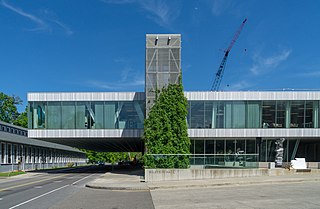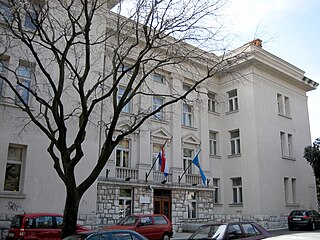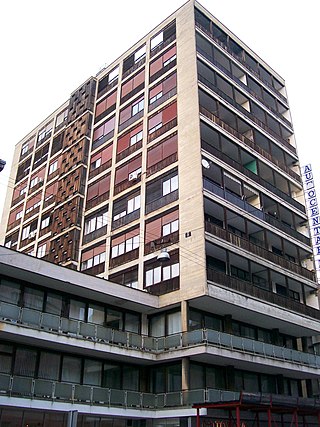
The University of Zagreb is a public research university in Zagreb, Croatia. It is the largest Croatian university and one of the oldest continuously operating universities in Europe. The University of Zagreb and the University North are the only public universities operating in Northern and Central Croatia.

Graz University of Technology is a public research university located in Styria, Austria. It was founded in 1811 by Archduke John of Austria and is the oldest science and technology research and educational institute in Austria. It currently comprises seven faculties and is a public university. It offers 19 bachelor's and 35 master's study programmes across all technology and natural sciences disciplines. Doctoral training is organised in 14 English-speaking doctoral schools. The university has more than 16,000 students, and around 1,800 students graduate every year. The Graz University of Technology and the University of Graz co-operate in teaching and research of natural sciences.
The Master of Architecture is a professional degree in architecture qualifying the graduate to move through the various stages of professional accreditation that result in receiving a license.

The College of Architecture, Art, and Planning (AAP) is the school of architecture at Cornell University in Ithaca, New York. It offers 20 undergraduate and graduate degrees in five departments: architecture, art, urban planning, real estate, and design technology. Aside from its main campus in Ithaca, AAP offers programs in Rome, Italy and in New York City, New York.

Brno University of Technology is a university located in Brno, Czech Republic. Being founded in 1899 and initially offering a single course in civil engineering, it grew to become a major technical Czech university with over 18,000 students enrolled at 8 faculties and 2 university institutes.
A Bachelor of Architecture (BArch) is a bachelor's degree designed to satisfy the academic requirement of practising architecture around the world.

The University of Split is a university located in Split, Croatia. It was founded in 1974. and is organized in 13 faculties and 124 faculty programmes. As of 2009, a total of approximately 40,000 students have graduated, and a total of 337 doctoral degrees have been awarded.

The University of Rijeka is in the city of Rijeka, Croatia, with faculties in cities throughout the regions of Primorje, Istria and Lika.
Stjepan Planić was a Croatian architect. His style can be described as a synthesis of functionalist and organic architecture.

Drago Ibler was a Croatian architect and pedagogue. His style can be described as pure simplicity and functional architecture.
The Faculty of Electrical Engineering and Computing is a faculty of the University of Zagreb. It is the largest technical faculty and the leading educational facility for research and development in the fields of electrical engineering and computing in Croatia.

The Faculty of Technical Sciences is a higher education institution located in Novi Sad, an independent part of the University of Novi Sad. It was founded on 18 May 1960 and today it is the largest faculty in Serbia by number of students and one of the largest in the region. As of 2020–21 academic year, it has a total of 15,742 students.

The Faculty of Geodesy at the University of Zagreb is the only Croatian institution providing high education in Geomatics engineering and the largest faculty in this domain in southeastern Europe.

Edvard Ravnikar was a Slovenian architect.

The Academy of Fine Arts Zagreb is a Croatian art school based in Zagreb. It is one of the three art academies affiliated with the University of Zagreb, along with the Academy of Dramatic Art (ADU) and the Academy of Music (MUZA).
Lavoslav Horvat was a Croatian architect.

Faculty of Science is a faculty of the University of Zagreb that comprises seven departments - biology, physics, chemistry, mathematics, geophysics, geography and geology. The Faculty has 288 full professors, associate and assistant professors, 180 junior researchers and about 6000 students.

Boris Magaš was a Croatian architect and architectural theorist, former Secretary of the Croatian Academy of Sciences and Arts and recipient of the Croatian National order of chivalry Order of Danica Hrvatska "Marko Marulić" for culture. He is best known for the Poljud stadium in Split and the Historical Museum of Bosnia and Herzegovina in Sarajevo.

Ivan Vulić is a Croatian architect. He graduated from the Gymnasium Vladimir Nazor in Zadar in 1975 and enrolled in Faculty of Architecture at University of Zagreb, where he studied under Božidar Rašica. Following graduation in 1980, he went to work for GP Ivan Lučić Lavčević in Split and ten years later become head of Lavčević's "Projektno-tehnološki biro" one of largest architecture bureaus in the country. In 1995 he left GP Lavčević to establish his own practice, VV-Projekt.
















